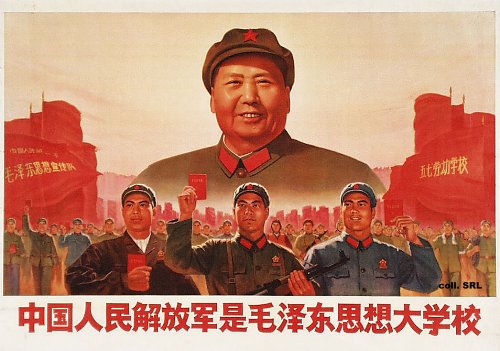

China, of course, also underwent a Socialist Revolution. Mao unified the once divided China under a central government. Like most other Socialist Revolutions, the Maoist revolution was successful primarily because there was such a widespread desire to expel the foreign imperialists that were controlling China. By the time of the revolution the Chinese people had already endured hundreds of years of foreign intervention and significant foreign control over the Chinese economy. The Opium War, Second Anglo-Chinese War, and Boxer rebellion of 1900 had already taken place. In retaliation to the Boxer Rebellion a huge international force of Western powers along with Japan invaded China, killing untold numbers of Chinese, likely over a million, and looting the country of precious treasures.
Looting was rampant and widespread during the China Relief Expedition of 1900, especially, it is reported, among the American Marines, who at the time were among the least disciplined members of the international expedition. There were also many cases of rape, of both boys and girls, the destruction of whole villages, and the shooting of civilians and even pets as they fled the invading international forces.
A US Army general commented that:
"The villages had been burned and looted by the allied columns, the people had fled from their homes... the sedgy banks of the Peiho were reeking with the stench from the floating bodies of dead Chinamen."
General Adna Chaffee reported that:
"It is safe to say that where one real Boxer has been killed since the capture of Peking, fifty harmless coolies or laborers on farms, including not a few women and children, have been slain."
Exact figures on casualties are not known, but tens of thousand of Boxers were killed in the expedition, so if what this general says is true then that would put the civilian casualties in the millions, which would not be surprising for that type of warfare at that time, especially when disease is factored in.
American forces sustained a loss of only 9 men through the entire campaign. The Boxers fought largely with no weapons at all and most of the killing was of civilians and unarmed fighters. There are several cases of thousands of men being killed by groups of a few hundred heavily armed men who suffered no losses.
Smedley Butler, just a young man at the time, wrote:
"Peking is a dirty slop hole as far as I can see. The Imperial City is a little better than the rest, and before the trouble, I imagine it was very handsome, but now, or at least up until last week or so, dead Chinamen adorn the highways with their swollen persons."
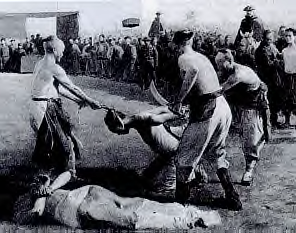
Chinese Boxers being beheaded under the supervision
of Western forces
For more on the Boxer Rebellion see:
http://www.geocities.com/Pentagon/Camp/7624/BoxerRebellion.htm
"In 1800, the per-capita standard of living in China exceeded that of Europe. Like India, China did not need or want Britain's products. However, Britain consumed large quantities of Chinese tea and, to avoid the loss of Britain's gold, it was imperative that something else be traded. Though it was done covertly and not acknowledged by the British government, it became official policy for British merchants to peddle opium to China. Opium [sold to China] was no hole-in-the-corner petty smuggling trade but probably the largest commerce of the time in any single commodity . This injustice was challenged by Chinese authorities (the Boxer Rebellion) but their attempt to maintain sovereignty was put down by a combined force of 20,000 British, French, Japanese, German, and United States troops (5,000 were Americans) led by a German general. It was a blatant attempt to carve up China between those imperial-centers-of-capital .
With the sales of opium exceeding the purchases of tea, Britain lost neither gold nor currency. Their capital and labor costs involved only an internal circulation of money. No wealth was lost to another society, which is the essence of a successful mercantilist policy. This appears productive only because the wealth gained or protected by Britain was considered; the much greater losses suffered by China, India, and much of the world were conveniently left uncalculated.
While the imperial-centers-of-capital were battling each other in WWII, China was laying its base for economic freedom. Although it is little known to Americans, after the war United States troops were guarding key rail lines and ports for the collapsing Chinese government and the OSS, precursor to the CIA, was busy ferrying Chiang Kai-shek's troops back and forth across China to suppress that revolution. However, China did break free in 1949, was marginalized for years by the imperial nations, yet still built a modest industrial capacity, and—by moving under the same protectionist umbrella as Japan, Taiwan, and South Korea—eventually averaged production gains of well over 10% a year."
http://www.ied.info/books/ed/british.html
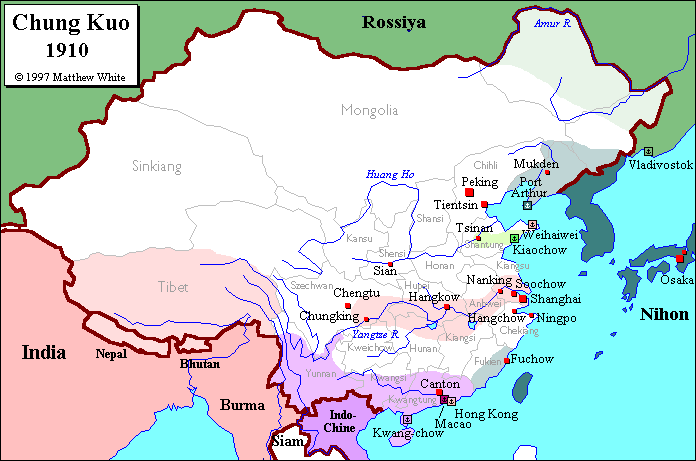
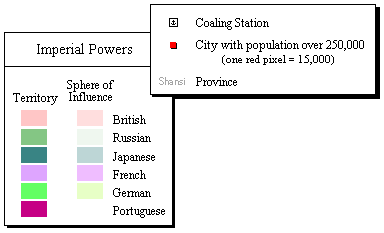
http://users.erols.com/mwhite28/chin1910.htm
The McKinley administration had proclaimed in 1898 that, "we must have Hawaii to help us get our share of China." Hawaii was obtained specifically for its significance in being able to help conquer Chinese territory. It was no secret that the world intended to conquer China and take its territory from the people. Virtually all the Western powers in addition to Japan and Czarist Russia had been engaged in this action. The world continued attempts to carve up China throughout the early part of the 20th century.
China entered a state of civil war in the 1920s in order to unite the fragmented nation. This effort was initially led by the Kuomintang. During the early stages of the efforts to untie the country the Kuomintang and Chinese Communists worked in loose cooperation, but in 1927 the Kuomintang, led by Chiang Kai-Shek, began systematically purging the growing Communists and so the People's Liberation Army, a.k.a. Red Army, was formed.
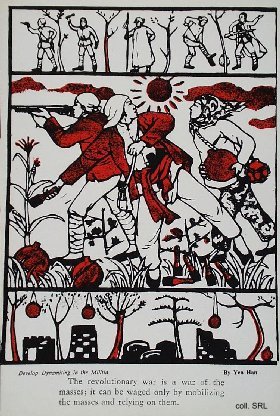
The civil war continued with the Kuomintang fighting the Soviet Chinese Republican army led by Mao. The Kuomintang were receiving support from the Nazis and by 1933 were receiving the assistance of Nazi German advisors. The Kuomintang were extremely corrupt and were fighting to secure a hierarchical dominance over the massive peasant population. Because of this Mao was able to generate great support for his movement among the peasants, who were quick to join his forces.
In 1937 the Japanese invaded China marking the start of the Second Sino-Japanese War. At this time the Kuomintang and Communists allied against the Japanese invaders. During this time, from 1937 until 1945 when World War II had ended, the Kuomintang and Communist armies still clashed with each other and were making preparations for the civil war that they knew would take place after the Japanese had been expelled.
Between 1917 and 1937 the following table gives some "best guess" estimates of the numbers of democides, political murders, committed by the various groups during the Chinese civil wars.
|
Committed by |
number killed |
| Kuomintang | 1,567,000 |
| Maoists | 893,000 |
| Warlords | 800,000 |
| Famine | 12,500,000 |
Throughout World War II, even though the Kuomintang were fighting against the Japanese invaders, they were still receiving aid from Nazi Germany, and in fact they also got aid from the USSR and America as well. They were playing all sides of the coin, getting aid from the Nazis to fight against the Communists, and getting aid from the USSR to fight against Japan. America was aiding them to fight both the Japanese and the Communists. There were repeated attempts by Americans, such as James Forrestal of Standard Oil and Allen Dulles, to get Chiang Kai-Shek to stop all fighting against the Japanese and instead focus all of their efforts against Mao's forces. The Kuomintang did do this to an extent, hoping that the Communists would be weakened by the attacks on the Japanese, however the opposite was actually the case. The top Kuomintang General, Tai Li, acknowledged during the war that Heinrich Himmler was his role model.
During the Second World War the Communist forces of Mao proved to be a superior fighting force and did most of the defending against the Japanese invaders, which not only brought them more support from the Chinese population, but more experience, loot, and territory as well.
The situation in China during WWII was very complex. It was a many sided war that was taking place in the middle of a civil war and international foreign invasion from all sides. Nazi, Russian, Japanese, and American forces were all fighting to try and take control of parts of China during WWII and were all using Chiang Kai-Shek and other warlords as their way to try and obtain that control. China sustained the second highest number of casualties during World War II after the Soviet Union. Over 11 million people were killed in China during the war.
After peace was signed with Japan, the United States immediately began a joint invasion of China with the Japanese to assist Chiang Kai-Shek in the fight against the Chinese Red Army. In the period between 1945 and 1949 the US sent over 2 billion dollars to the forces of Chiang Kai-Shek, helped to train Kuomintang soldiers, and sent 100,000 American troops to China to help fight against the Red Army. This, of course, is all very little known among Americans.
Despite this, hundreds of thousands of soldiers of the Kuomintang forces defected to the Communists because of the rampant and blatant corruption of the Kuomintang, which was partly fueled by the American money which flowed freely to them after the war.
Chiang Kai-Shek and his forces eventually lost control in mainland China and retreated to Taiwan where they proceeded to kill 28,000 civilians in their takeover the island.
The government of Chiang Kai-Shek, based in Taiwan, was recognized by the United States, and most of the rest of the world, as the only legitimate government of the nation of China until after the death of Chiang Kai-Shek.
Mao's Revolution was a peasant revolution, and this caused a great deal of conflict with Stalin and other Communists because Communist Revolutionary ideology is based on the concept of a workers revolution, not a peasant revolution. However, Mao had built his base of support among the farmers so as his forces "liberated" cities from Kuomintang or other rule, they often viewed workers as enemies, even if they were Communists. This caused the strange situation of Communist workers welcoming Mao's forces as liberators, only to have them turn against them. Mao's Revolution was in some ways a case of farmers simply taking control of the country and opposing all who stood in their way. Because of this many of the people who were executed or imprisoned during the early Maoist takeover were Marxists and Communists.
Though many Chinese opposed Maoist rule, when America invaded Korea the Chinese population united behind Mao out of increased fear of American imperialism. This is perhaps the greatest irony of the Communist movement in China. One of the most significant factors that led to the success of the Communist takeover of China was the American invasion of China and Korea to “fight Communism”.
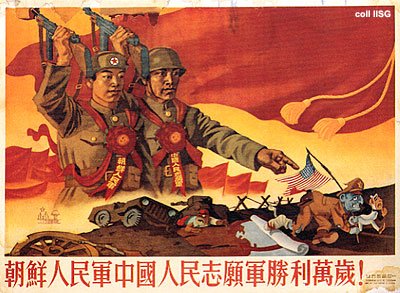
Once Communist Party control of China had been established Maoist China developed through a series of programs:
The Transition to Socialism - 1953 to 1957

The Great Leap Forward - 1958 to 1960
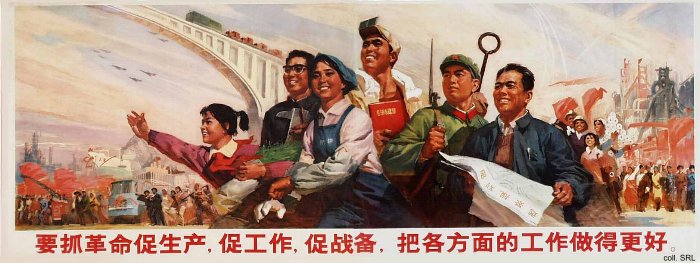
Readjustment and Recovery - 1961 to 1965
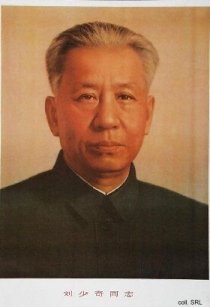
Liu Shaoqi
The Cultural Revolution - 1966 to 1976
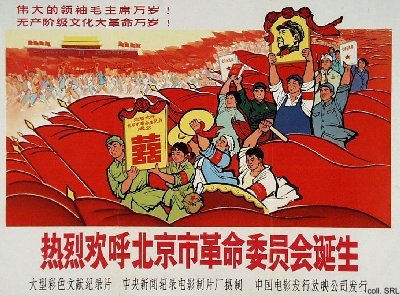
The economy that developed in China during the Maoist period is best described as "state-capitalism". China was run, and continues to be run, as one giant corproation.
In 1953 Chairman Mao wrote:
"The present-day capitalist economy in China is a capitalist economy which for the most part is under the control of the People's Government and which is linked with the state-owned socialist economy in various forms and supervised by the workers. It is not an ordinary but a particular kind of capitalist economy, namely, a state-capitalist economy of a new type. It exists not chiefly to make profits for the capitalists but to meet the needs of the people and the state. True, a share of the profits produced by the workers goes to the capitalists, but that is only a small part, about one quarter, of the total. The remaining three quarters are produced for the workers (in the form of the welfare fund), for the state (in the form of income tax) and for expanding productive capacity (a small part of which produces profits for the capitalists). Therefore, this state-capitalist economy of a new type takes on a socialist character to a very great extent and benefits the workers and the state."
For more on Communist China, Mao, and the Kuomintang see:
http://www.marxists.org/reference/archive/mao/
http://www-chaos.umd.edu/history/toc.html
http://www.wikipedia.org/wiki/Chinese_Civil_War
http://home.att.net/~m.standridge/Chiang.htm
http://www.sasked.gov.sk.ca/docs/history20/u3ct9.html
http://www.infoplease.com/ce6/history/A0828370.html
http://www.wsu.edu:8001/~dee/MODCHINA/COMM2.HTM
| Previous | Next | Contents |
|
| ||||||||||||||||